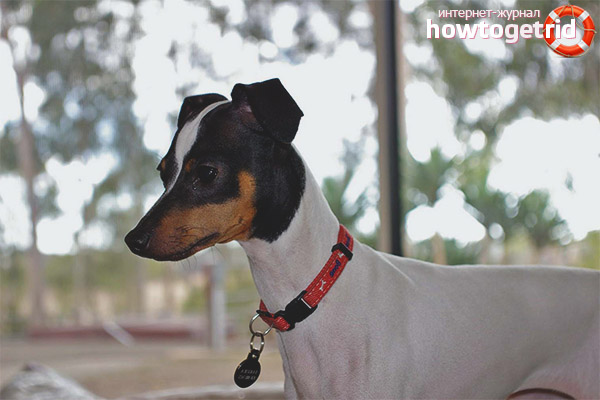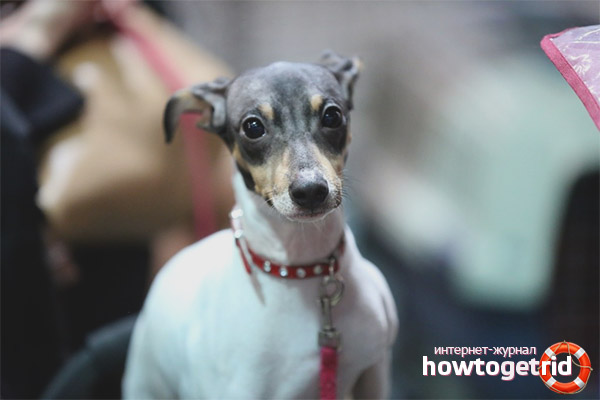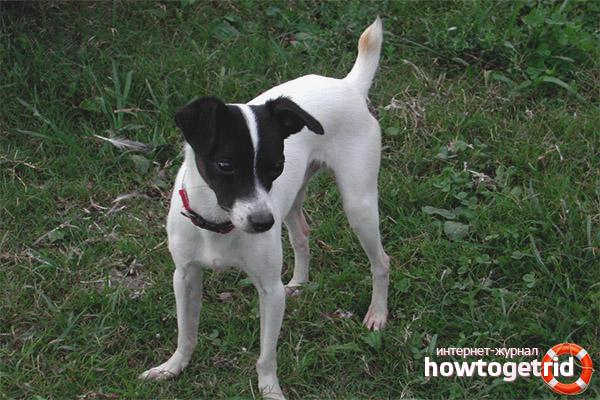The content of the article
Not many people, including dog breeders, have heard of a breed like the Japanese Terrier. There is nothing surprising. Represented individuals, even in their homeland, do not have a high number. The main distinguishing features of these terriers from self-similar are color, as well as obstinate temper and fearlessness. At the same time, dogs can be affectionate and companionable if properly trained. If these representatives of the breed are so good, why not everyone is trying to bring them into the house? Let's analyze the main aspects.
Breed description
Dogs are suitable for service, they are often taken with them for hunting. Pets are very hardy, go with a person to a waterfowl or small game. Excellent performance is due to good health and a desire to help.
It is noteworthy that in the process of breeding the species, the breeders did not set themselves the task of obtaining a working “horse”. They wanted to breed a decorative companion dog so that the pet would travel everywhere with the owner.
Otherwise, the dog of the breed presented is called nihon. It is understood as a miniature individual with a harmonious body and strong muscles. The coat is short. If the animal participates in exhibitions, experts evaluate the complexity of the body. By nature, the dog is active, cheerful and sincere.
Breed standard
According to generally accepted standards, one can distinguish the main characteristics that are evaluated at exhibitions. This data should not be blurry, everything is extremely clear.
- The head is medium in size, the frontal part is narrow and flat. The cheekbones are compacted, the transition from the frontal part to the muzzle is weakly expressed. It is rather smooth. The nose is straight and ends with a movable nose with a black pigmented lobe.
- The eyes are oval, medium in size, with a brownish iris. The teeth are white, the bite is correct, scissor-like. The lips are adjacent to the jaws, the teeth do not stick out.
- Ears are set high, thin and small in structure. The format of the triangle is falling into the front of the head. By standards, it is allowed that the ears have folds or are located near the cheekbones.
- The neck is not long, but not short, but rather medium. Muscular, strong, expanding from head to shoulders. It is covered with a skin that does not form wrinkles or wrinkles.
- The withers are clearly visible, considered high, gently flowing into a flat and inflated back. Croup oblique, loin visible. The sternum is moderately deepened, but does not have sufficient width. Ribs are rounded and developed. The groin is picked up, the line of the abdomen is clearly developed.
- The forearms are straight in format, the shoulders are located with some sloping. The backbone is not massive, the dog looks thin. Hips are long, knees and hocks are normal. The paws themselves are gathered in a ball, the pillows are fleshy, hard, claws are black or so.
- In their movements, the dogs are fast, as if springing when walking or running. Coat is strictly short; long coat is unacceptable. The same can be said of overshot or overshot (vices).
Character
- It is not without reason that representatives of this breed are considered excellent companions. For these tasks, they are endowed with all the qualities. Dogs are active, so they need a master with the appropriate temperament. Dogs will be great mates for jogging and long walks. At the same time, the dog is endowed with modesty; he will not be imposed, waiting for attention.
- If you take into account the numerous reviews, then it is worth saying the following.Dogs of this breed are called zinger for the ability to cheer up everyone around. Nihon is ideal for living in a large family, but will choose one owner and will obey him in everything. Companion traits appear at an early age.
- Despite their rather modest size, Japanese terriers are not cowardly. In some situations, they show unwarranted fearlessness, for example, when they attack larger dogs in size, protecting the owner.
- To prevent skirmishes, the animal is socialized early and taught not to rush at large relatives. Otherwise injuries cannot be avoided. The dog will consider it a threat if a person actively gestures or expresses himself loudly.
- Japanese dogs are not suitable for keeping people who do not like loud barking. Terriers show their emotions, barking. The animal can stand at the door, swearing frantically at passers-by. The same goes for street behavior. Many owners say that weaning a dog from this habit will not work.
Training and education
- The individuals of this breed are distinguished by high intelligence. Therefore, training such dogs is a pleasure. They are given a basic program without any problems. In addition, you can teach your pet complex tricks. It is worth noting that training will occur as fruitfully as possible.
- In this case, only patience is required from the owner. Also, the dog should be treated with all respect. At the same time, gentleness on your part is forbidden. During the lessons, hardness should be felt in your voice. It is strictly forbidden to resort to physical impact, rudeness and harshness.
- The animal is smart enough and always understands the change in intonation. Therefore, as a punishment, the dog should say a few strict phrases. The dog reacts sharply to a change in the mood of his master. Do not forget about encouraging the animal for successful training. For this, it will be enough favorite treats and affection.
- In order to establish the most friendly and trusting relationship with the pet, it is recommended to come up with joint games. Such terriers belong to hardy dogs, but they can still get tired of the monotonous execution of commands. Therefore, regularly take breaks and play with your pet.
Care
- Japanese terriers do not need special care, so they are considered completely unpretentious. Even a novice can handle such a dog. The only thing to note is that the pet needs constant attention. To do this, it is enough to systematically play with the animal and conduct active walks.
- From time to time after visiting the streets, clean the dog’s coat with a soft brush. Wet wipes are an alternative. Often there is no need to bathe a pet. After water procedures, immediately wrap the terrier with a towel, it can catch a cold.
- If the animal is completely healthy and eats properly, then you will not feel the smell of a dog from it. The advantage of the breed is that they have no undercoat. Shedding of such dogs occurs twice a year. In autumn and spring, the wool needs to be collected from the pet with a special glove or brush.
- Keep in mind that the teeth of the animal must be monitored, especially during their shift. At six months of age, puppies often form a stone. It is for this reason that the teeth of the animal must be brushed up to 3-4 times a week. If you cannot cope with the task yourself, contact your veterinarian.
- If the puppy's dentition forms correctly, then no problems arise. However, cleaning should still be carried out regularly. Preventive procedures will not be redundant. The rest of the care for the terrier is no different from other dogs. Do not forget to take vaccinations and prevent worms.
Feeding
- Keep in mind that Japanese terriers are charming and actively use this when manipulating people. Do not succumb to provocations and do not treat your pet with human food. The problem is that various foods negatively affect a dog’s health.
- If you give your pet sweet food, his teeth will soon begin to deteriorate. Sugar also causes diabetes and impaired vision in dogs. In no case do not give the animal sausages, sweet cookies and similar delicacies.
- It is allowed to feed a dog exclusively with natural products. They should not contain artificial components. Do not forget that the pet must have a sufficient amount of meat in the diet. Also give boiled fish and offal.
- If you decide to feed the animal homemade food, then do not forget about cereals. They should be a quarter of the total diet. Vegetables, herbs and high-quality vegetable oil are allowed to be added to porridge. In addition to this, systematically give your dog special vitamin complexes.
- Independently make a high-quality diet, the task is not for everyone. Therefore, if you do not want to do this, consider the option with ready-made premium feeds. In this case, no additional vitamins will have to be given. The feed contains everything you need.
Content
- It is worth knowing that the Japanese terrier is suitable exclusively for keeping at home. On the street, even in a booth, a dog cannot live.
- Provide your animal with a nook with soft bedding. As an alternative, a ready-made dog house is suitable.
- If you live in a private house, your pet is allowed to let go for a walk in its own courtyard. The terrier should have its own bowls for water and food.
- Also highlight toys for the animal. In the cold season, the dog will need warm clothes. The rest of the content does not cause any difficulties.
Dogs of this family look, to put it mildly, strange. The body is painted white, the head is black. But this makes them even more mysterious and original. Surprising is considered not only the appearance, but also the temperament, we examined all aspects above.













Submit